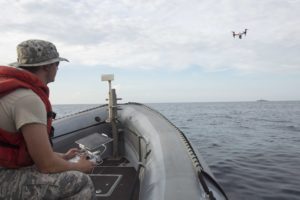
Navy photo by Mass Communication Specialist 1st Class Maddelin Angebrand
The U.S. Navy is testing a virtual net it hopes can both detect and splash rogue drones before they become a clear and present danger.
During an exercise last week, missile destroyers USS Lassen and USS Jason Dunham checked out an anti-drone capability sensor system in the Gulf of Mexico that tracked quadcopters launched by U.S. Air Force Academy cadets.
“The goal here is to test our organic sensors radar systems, camera systems and interface with the shore side operators who are testing systems for the same purpose,” USS Dunham Combat Systems Officer Lt. Cmdr. Carl Poe said in a press release.
“We want to communicate and coordinate to expand our battle space and reduce reaction time we have from detection to engagement of these [drones].”
No drones were actually destroyed or captured during the exercise (dubbed Black Dart). However, the exercises allowed naval forces to coordinate a simulated anti-drone exercise both in a novice phase, in which the drone route was known, and in a more advanced simulation where the drone’s route remained unknown.
“We got a lot of work accomplished yesterday validating and experimenting with new systems that we have,” said Cmdr. Kevin Hoffman, Jason Dunham’s commanding officer.
“Overall, the communication across all the Department of Defense agencies and different entities that we have here has been great. We have the opportunity to employ some systems that we have not tested before, so it’s a great experience for not only the ship, but the outside operators as well.”
For the Air Force cadets, the exercise served as an introduction to quad-copter flights over the ocean. Hoffman said the cadets were able to land the drones within a two-foot by two-foot space.
“[The drone launch] allowed us to test our detection capabilities, and evaluate our tactics, techniques and procedures, which is what Black Dart is allowing us to focus on.”
Black Dart is one more way the U.S. military is gearing up to defend against hostile drone attacks.
Last month, the Defense Advanced Research Projects Agency’s Tactical Technology Office publicized a request for information to help create “novel, flexible, mobile layered” anti-drone solutions to defend “fixed and mobile ground and naval forces from possible drone threats.”
At the Navy’s recent Sea-Air-Space exhibition, Battelle’s DroneDefender anti-UAV rifle generated a lot of buzz as well.
 Unmanned Aerial Vehicle The latest drone news
Unmanned Aerial Vehicle The latest drone news



